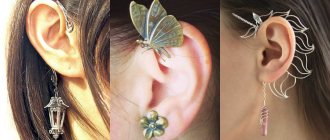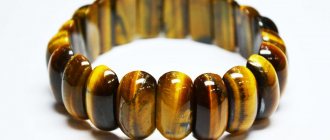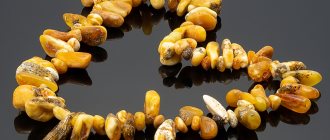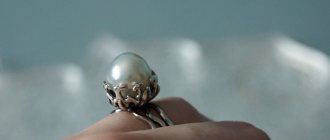Jewelry was founded in September 1991 in Moscow. Initially, the company's employees developed the design and created interior elements of jewelry with precious and semi-precious stones.
Later, Cameo began producing wedding rings, which quickly gained extraordinary popularity. Today, every third wedding ring sold in Russia is made specifically at. A wide range of products, an extensive network of regional offices, modern Italian equipment - these are the factors thanks to which Cameo has become one of the leading jewelry brands on the Russian jewelry market.
Quality and affordable prices are the company's goal.
Cameo produces jewelry that is in mass demand; it looks chic in appearance, but is also affordable for most consumers. Complex technical techniques used in production: setting stones, combining inserts, processing and shape of the alloy give rise to unique collections. These are exclusive jewelry with cubic zirconias, white sapphires, unique semi-precious stones and much more.
The jewelry company follows new products on the European jewelry market and does a lot to ensure that its products are fashionable and in demand. The company's goal is to turn the purchase of jewelry into a simple process that brings pleasure to the buyer, without much thought or hesitation. Going for jewelry is like going to the store for a cake! To achieve this, much attention is paid to pricing policy and assortment.
What is a cameo? History of the cameo from antiquity to the present
History of the cameo
A cameo is an ornament carved from precious or semi-precious stones. Unlike intaglios, in which the image is recessed, cameos always have convex images. The art of making such jewelry is called glyptics.
Cameos became widespread in the ancient world. Special stones were chosen for them - jasper, agate, sardonyx - with even, straight layers. Figures and portraits were cut out from the light layers, and the darker ones were left as the background. The cameos depicted Greek and Roman heroes, gods and goddesses, poets and philosophers. Cameos were worn by both women and men. They were awarded to soldiers for fearlessness in battle.
The Hermitage Museum in St. Petersburg houses the world famous "Gonzaga Cameo", carved on three-layer onyx (sardonyx). It is rightly called the pearl of glyptics. It was made by a master of the 3rd century. BC. in Alexandria. It depicts King Ptolemy II Philadelphus and his sister-wife Arsinoe in profile.
Cameo Gonzaga
The history of this cameo is long and complicated. It is known that in the middle of the 16th century. it was in the treasury of the Dukes of Gonzaga in Italy, and after several changes of owners it fell into the hands of Napoleon Bonaparte. In 1814, in Paris, his wife Josephine presented the cameo as a gift to Emperor Alexander II, by whose order it was transferred to the Hermitage for storage.
With the capture of Rome by the barbarians, the art of cameo making was forgotten for a long time. Interest in them arose again during the Renaissance. Images of famous contemporaries, made in the style of antique cameos, became popular. Craftsmen often inserted cameos into frames made of gold, multi-colored enamels, and framed with precious stones. Queen Elizabeth of England loved to give cameos with her image made of sardonyx, some were so small that they were used to decorate rings, several larger ones often served as medallions. And the queen herself loved to wear cameos. It was fashionable among noble ladies of that time.
Cameo depicting Elizabeth I
Cameos came back into fashion at the end of the 18th century. The popularity of cameos was promoted by Napoleon's conquests in Italy and Egypt, from where the emperor brought a lot of jewelry in the classical style - gems. If you believe the portraits, noble ladies decorated their outfits with them, in particular, Napoleon’s wife, Empress Josephine. (Please note that there are cameos in the head decoration and dress decoration).
Portrait of Empress Josephine, wife of Napoleon Bonaparte
At the same time, cameos carved from mother-of-pearl shells gained popularity.
New materials for making cameos have also appeared: for example, volcanic lava of various shades - white, beige, olive, gray, brown. Scotsman James Tassier proposed casting cameos from multi-colored glass and setting them in silver and gold. The Wedgwood porcelain manufactory in England began producing cameos from faience in white and blue. They were made in round, oval, octagonal shapes, framed in gold and silver.
Mother-of-pearl cameo
Porcelain cameo
Volcanic rock cameo
In Russia, cameos were especially popular at the beginning of the 19th century. They were inserted into brooches, medallions, rings, and sprinkled with diamonds and emeralds. They depicted ancient scenes, as well as Russian emperors and empresses. At the same time, the stones and subjects corresponded to their intended purpose. Thus, mourning cameos were made from black stones, on which Persephone was often carved, abducted by the god of the world of the dead, Hades. Wedding ones were made from carnelian, often with images of Cupid and Psyche - a symbol of true love. Marine scenes or figures of Neptune and tritons were carved into aquamarine. On the amethyst, which supposedly protected against intoxication, is the god of fun and winemaking, Bacchus. Lawyers and judges wore blood-red jasper jewelry.
Beginning of the 20th century - the time of the beginning of mass production of cameos from shells. Italy was famous for this. But many of them were fakes - heads were cut out of white shells, which were then glued onto a pink shell or agate. And soon they came up with the idea of making cameos cast from plastic - brooches and medallions for the poor.
Such cameos are the most common nowadays and the most budget-friendly of all.
Thank you for your attention!
If you liked the article, write comments. I will be happy to answer all your questions.
A large assortment of products is another secret of popularity.
The company's target audience is women and men of all ages, students and businessmen, progressive youth. The assortment includes jewelry in retro style and in the style of modern minimalism, sophisticated and massive, with and without stones. Thanks to the large selection, the company's products are absolutely in demand. These are wedding rings, gold bracelets and congo earrings, gold jewelry with pearls, semi-precious and precious stones.
Cameo takes care of its client even after he purchases the product. With each piece of jewelry, the company also sells a “customer portrait,” a kind of recommendation on how and where to wear the product.
At the Sibuvelier 2013 exhibition held recently in Novosibirsk, the “Victory Femininity” and “Harmonious Diversity” collections from the Cameo jewelry brand won two of the four possible medals in the exhibition competition among the best jewelry of 2013. The artistic expressiveness and spectacular color combinations of precious inserts in these collections were noted.
And according to the final data of the Assay Office for 2012, Cameo entered the top ten largest jewelry manufacturers in Russia. This rating is compiled on the basis of the mass of gold products that were received for testing and hallmarking for the entire year.
The official website of the company" published by ffurik | | publish your brand
| Tweet |
<< previous brandnext brand >>
The Cameo Mystery
The SOKOLOV company values the long traditions of jewelry craft and draws its inspiration from the cultures of different countries and eras, combining them with modern production technologies. Thus, fundamentally new jewelry appeared among the brand’s jewelry masterpieces. Following current trends in world fashion, SOKOLOV designers have developed vintage jewelry using the bas-relief technique of oval, round and square shapes with cameos and precious stones.
History of art
The art of making cameos dates back to the 4th century BC. Then the ancient Greek artisans first began to carve patterns on stones and sea shells. During the Renaissance, unusual brooches and medallions experienced a real heyday - they became incredibly popular among noble ladies of Europe. Today, cameos are rapidly returning to women's boxes. In our age of super technology, people increasingly value unique handmade products made from rare and natural materials.
Mastery of Generations
Having discovered all the attractiveness and nobility of such jewelry, SOKOLOV maintains a good friendship with the family Italian company that creates cameo jewelry inserts. For more than three generations, the success of this family production has been based on a love of beauty, passion for art and pride in tradition, which is so close to our family brand.
All Italian cameos are engraved exclusively on sea shells. A natural cameo is created from a sardonyx shell. Sardonyx shells consist of natural two-color layers: a white top, which is engraved, and a lower brown background. These shells are mined in the Bahamas, Cuba and Honduras. Each of them is different in shape, so they need to be processed manually and one by one. It's a product of nature, so even if two samples look similar, they will never actually be 100 percent the same! Machine processing of shells is not possible, since this would require reconfiguring the equipment for each sample, which would make the process impossibly long.
There are no more than 40 experienced carvers in this market, plus a number of “assistant” carvers. 30 of them work in the leading company in Italy, which has become a partner of SOKOLOV.
In one week, a carver can make about 6 oval cameos with a diameter of 45 mm. An experienced craftsman requires 9 years of specialized training and more than 10 years of continuous practice before he can begin to work.
The cameo has become one of the most coveted handmade jewelry items for “hunters” of Italian beauty.
The embodiment of ideals
Jewelry with cameos from the new SOKOLOV line was included in the Vintage capsule collection, the presentation of which took place at the JUNWEX Moscow 2021 exhibition.
The setting of cameos in each piece of jewelry is also done exclusively by hand by SOKOLOV jewelers. Special skills are required to securely fix the embossed insert and not damage it. The thin diamond frame of the cameo is made in exactly the same way.
No matter how time changes, art is eternal. The author's design, the creation of nature and the handiwork of Italian carvers are combined in an exquisite collection, where each piece of jewelry is unique.
What is the appeal for modern collectors?
“These ancient engraved gemstones offer a fascinating scientific window into the ancient world in terms of life, fashion and ritual, and prove that the tradition for sentimental jewelry goes back thousands of years,” says Bernheimer.
Roman Cameo of Sardonyx Medusa, circa 1st century AD. e. Cameo: 1 in (4 cm) long; Mount: 2⅜ in (6 cm) long. Sold for $181,250 on April 29, 2021 at Christie's New York
“Cameos and intaglios are beautiful decorative and evocative works of art that, due to their natural hardness, are often preserved in brilliant condition,” continues the specialist. “Thanks to their portability, they can be worn in a modern style and manner, while their abundance means that the most affordable examples start from just a few hundred pounds.
What is a cameo?
The art of artistic stone cutting was extremely widespread back in the era of antiquity. It was then, no less than four hundred years BC, that the first cameos were made. This is the name for products made from solid natural stone with colored veins, which are bas-relief (convex) images of people, animals or plants. The art of the carver is that the image is made in a layer of one color, and the background is represented by another, usually darker layer. Some products combine two or three colors in a design with subtle transitions between them.
The cameo technique eliminates the gluing of colored figures onto a smooth background plate. The background and image are always solid stone. This is precisely the main value of the cameo. Each such product is unique, since the individual structure of the mineral excludes the possibility of mechanical copying of identical designs. The master is forced to obey the rhythm of alternating multi-colored veins, inventing his own unique decor for each decoration. Even if the images appear to be the same (for example, on cufflinks or earrings), they are not exact copies of each other.











